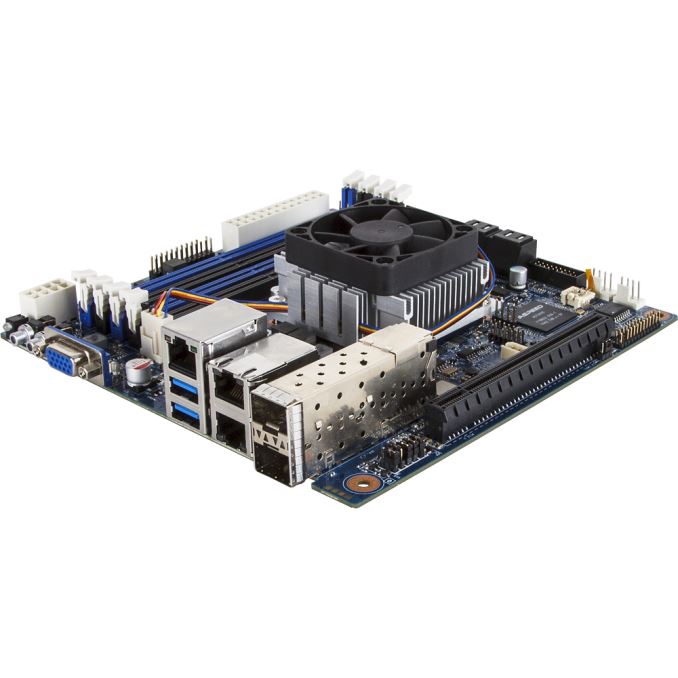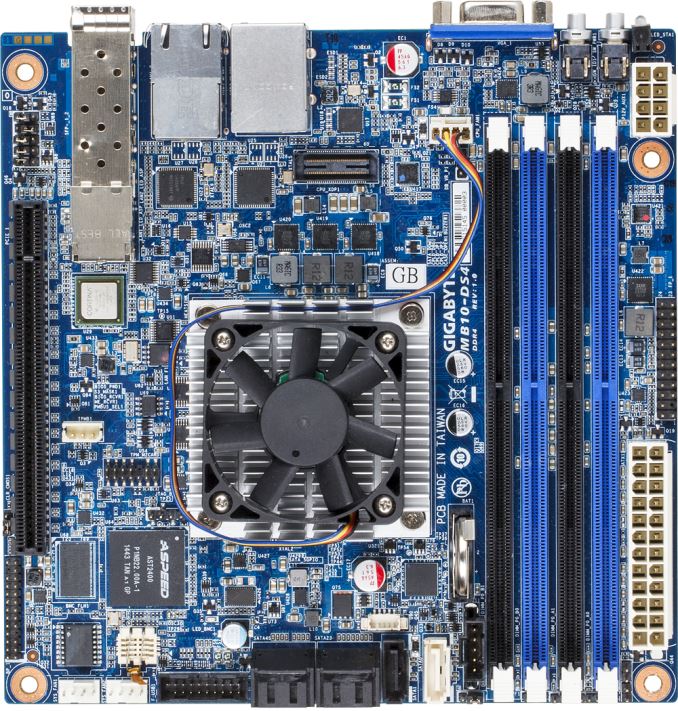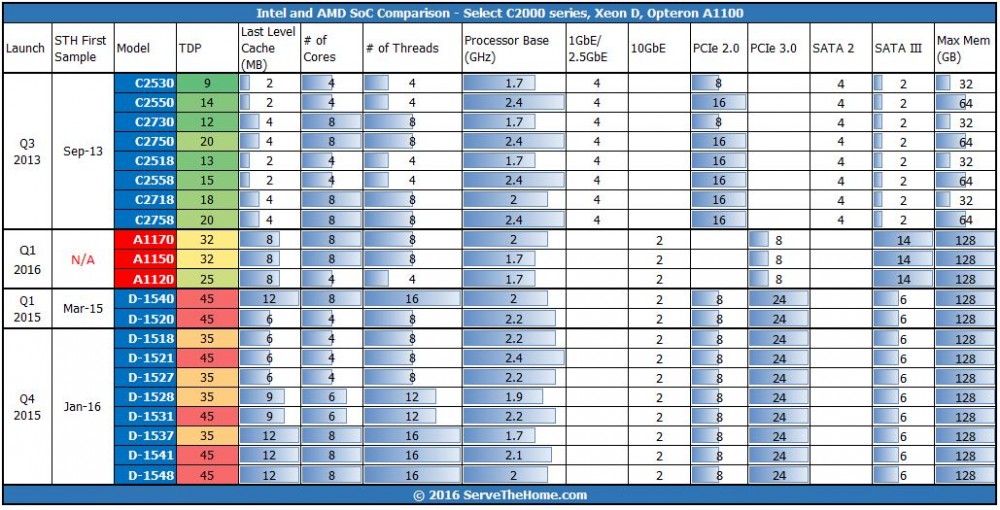New GIGABYTE Server Motherboards Show Xeon D Round 2
by Ian Cutress on January 18, 2016 8:00 AM EST- Posted in
- Motherboards
- Networking
- Gigabyte
- NAS
- Enterprise
- Servers
- Xeon-D
- Broadwell-DE
- SFP+

The Xeon D platform, as reviewed by Johan back in June, put together eight Broadwell cores, 24 PCIe 3.0 lanes, dual 10 Gbit Ethernet and USB/SATA control all into one SoC within a 45W TDP design. It almost sounded too good to be true (I’ve run some benchmarks my side, to be in a review later), as this is the only real way to get eight 14nm cores into a single die. Even at 2 GHz, Johan’s piece showed that the Xeon D based on Broadwell aims to fit between the Xeon E3 and Xeon E5 in terms of performance and power efficiency, and to quote Johan ‘Xeon D is probably the most awesome product Intel has delivered in years, even if it is slightly hidden away from the mainstream’. There is interest both server side and NAS side for this, and with the next wave of Xeon D parts being introduced GIGABYTE Server is one of the first to announce some new models.
Technically, the four motherboards being launched are a single base design, but with either a different SoC or different networking:
| 2 x 1 GbE + 2 x 10GbE SFP+ |
2 x 1 GbE Only |
|
| With Xeon D-1541 | MB10-DS3 | MB10-DS0 |
| With Xeon D-1521 | MB10-DS4 | MB10-DS1 |
The image above is the top end MB10-DS3 model, featuring the Xeon D-1541 processor with 8 cores, 16 threads, running at 2.1/2.7 GHz for base and turbo frequencies. This is a mini-ITX board aimed at the typical 1U chassis, with four RDIMM/UDIMM DDR4 slots for up to 128 GB RDIMM support in ECC or non-ECC fashion. As mentioned before, the differentiator on this model aside from the SoC is the networking, and here we get dual Intel I210-V gigabit Ethernet paired with dual Cortina CS4227 10GbE SFP+ LAN ports to either route teamed to an SFP+ switch or to different switches althogther.
The motherboard uses a single PCIe 3.0 x16 slot which can be used for compute, and storage comes via five SATA 6 Gbps ports and another similar port that also supports SATA DOM. With it being a server motherboard, the onboard Aspeed AST2400 provides an IPMI interface for management as well as a 2D acceleration video chip. There are two extra fan headers on board, as well as a USB 3.0 header and a TPM header.
The SoC here has a list price of $581 on its own, and given that this is a server part I’m not too sure we will see these set of boards actually up at retail, although I do know that GIGABYTE Server is trying to push more product through that distribution channel. Businesses interested in the platform will have to enquire to their local GIGABYTE office to find out more information on pricing and availability.
As part of the second wave of Xeon D processors, Intel seems to be releasing a number of 35W and 45W models, from four cores to eight cores (with Hyperthreading), varying otherwise by speed and last level cache in-line with core count. I imagine that as more of these trickle through into the hands of OEMs, we will see more products through 2016.
Table of Xeon-D processors from ServeTheHome













23 Comments
View All Comments
icrf - Monday, January 18, 2016 - link
Two questions:1) Are we ever going to see non-uITX boards with Xeon-D? I can't be the only one interested in low power but aren't constrained by physical space and would rather have expandability.
2) How does a low power E3 compare to the Xeon-D? I know CPU TDP can get close, but I'm thinking about the platform as a whole. Xeon-D seems more integrated and designed for low power. I don't know how E3 would do at lower load levels.
bill.rookard - Monday, January 18, 2016 - link
While they certainly could build a bigger board, the whole point on this type of chip is low profile, low power, high core density servers which means 1U. Because you could only lay down at most two expansion PCIe boards sideways in a chassis, that limits the expansion right off the bat.According to the SOC block diagram, they have 8 PCIe v2 lanes available, and 24 PCIe v3 lanes available which seems to leave a lot of potential on the table. However, with a bigger chassis (2u-4u), you have more thermal capacity which means you can step up to the bigger (or multiple) Xeons.
What would be interesting is a small workstation type computer taking advantage of the cores and some dual graphics cards. It could be done with the same ITX board with a special riser without expanding the board though.
ZeDestructor - Monday, January 18, 2016 - link
You can fit two PCIe cards in 1U very easily, though you do need risers to do so. It's impractical to do using any ATX-based form factor though, because of all the stuff on the board itself, unless you use PCIe extension cables of course, shich may well be an option if you PSUs are small enough.ZeDestructor - Monday, January 18, 2016 - link
The reason why an mATX version would be nice would be for storage nodes, where a single HBA may not be sufficient, and the chassis is a bigger 2-4U affairicrf - Monday, January 18, 2016 - link
And that's almost exactly my use case. Having physical space and ability to dissipate heat and doesn't mean I have a desire to dissipate heat (paying for it twice).The box won't be pure storage, so more grunt than Atom-class is pretty strongly desired. Hence Xeon-D looking nice on paper as a CPU/SoC, but no one making a board I want with it.
icrf - Monday, January 18, 2016 - link
And I fully understand that's the biggest market, but there are niche boards for all sorts of things. A SOHO storage/virtualization all-in-one isn't that unusual.starkruzr - Sunday, February 14, 2016 - link
This is my use case. I'm trying to rebuild the cobbled-together home virtual host I use as a lab environment with a new case with a hot-swappable RAID10 backplane; currently I'm using a USB3 external array, which actually does the job pretty well but has no way of notifying the OS when a drive fails.ZeDestructor - Monday, January 18, 2016 - link
http://www.anandtech.com/show/9754/asrock-rack-lau... right here :)icrf - Monday, January 18, 2016 - link
Been eyeing the spec sheet for that board for more than six months. I've yet to see it available for purchase anywhere, or even a price for it, which I suspect may scare me off. I'm disappointed that Xeon-D was "launched" back in March of last year, and that piece of vaporware is the closest thing I've seen to something beyond mITX. If I don't have space constraints, give me access to all those PCIe lanes available.ZeDestructor - Tuesday, January 19, 2016 - link
the "vaporware" feel of Xeon-D is mostly because the big cloud companies (think Google and AWS) are gobbling up all the supply. Quite annoying I feel, but that's how the market is now....